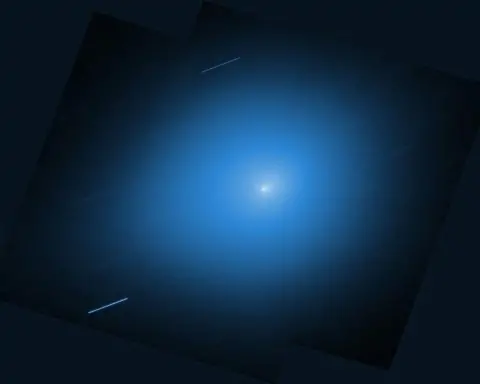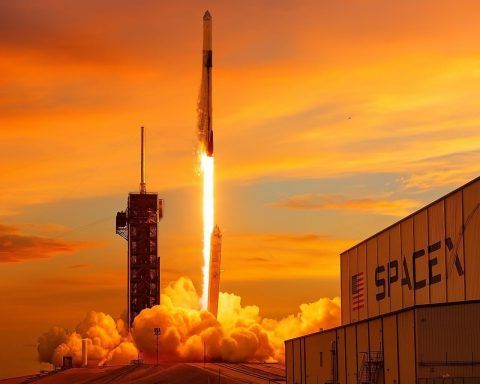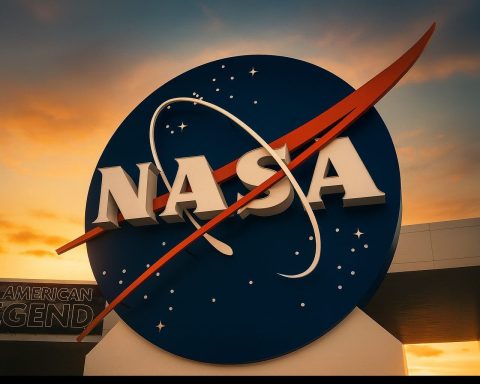Crewed Missions & Space Station Updates
- SpaceX Crew-11 Arrives at ISS in Record Time:NASA’s SpaceX Crew-11 mission reached the International Space Station (ISS) early on Aug. 2, docking at 2:26 a.m. EDT – less than 15 hours after launch [1]. This rapid rendezvous (a U.S. record for crew missions) delivered four new crew members: NASA astronauts Zena Cardman and Mike Fincke, JAXA astronaut Kimiya Yui, and Roscosmos cosmonaut Oleg Platonov [2]. Their Dragon capsule Endeavour lifted off Aug. 1 and autonomously docked to the Harmony module, bringing the station’s population to 11 (until the previous crew departs next week) [3] [4]. Notably, all four Crew-11 astronauts were originally assigned to other flights – Cardman and a crewmate were bumped from a 2024 SpaceX flight to accommodate two NASA astronauts who’ve been stuck waiting on Boeing’s delayed Starliner, and Fincke and Yui had trained for Starliner as well [5]. (Boeing’s Starliner capsule remains grounded by technical problems until at least 2026, forcing NASA to lean on SpaceX for crew transport.) Despite the shuffle, Crew-11’s arrival was smooth: “Hello, space station!” Fincke radioed upon docking [6]. While 15 hours launch-to-dock is speedy by U.S. standards, Russia still holds the record with a just 3-hour trip to ISS [7].
- Blue Origin Launches 6 Space Tourists (Aug. 3):Jeff Bezos’ Blue Origin returned to crewed suborbital flights, launching its NS-34 mission from West Texas on Aug. 3. Among the six passengers was Justin Sun, a 34-year-old crypto billionaire (founder of the Tron blockchain) who had bid $28M for a seat on Blue Origin’s first flight back in 2021 [8]. Liftoff of the New Shepard rocket occurred at 8:30 a.m. ET, with Blue Origin’s webcast streaming the event live [9]. Sun was joined by a diverse crew of private adventurers – for example, Arvinder “Arvi” Singh Bahal, an Indian-born American investor and explorer, and Deborah Martorell, a meteorologist from Puerto Rico [10]. Also on board were a Turkish entrepreneur/photographer, a British humanitarian, and J.D. Russell, an American who had flown on Blue’s 2024 launch [11]. This 12th Blue Origin tourism flight (and first in several months) underscores the rebounding space tourism industry. The capsule’s brief journey gave the civilian crew about 3–4 minutes of weightlessness above the Kármán line before parachuting back to Earth. (Blue Origin had paused flights after an uncrewed booster failure in 2022, so this successful crew launch is a milestone in resuming suborbital tourism.)
- Space Station Handover and Activities: With Crew-11’s arrival, ISS Expedition 73 is in full swing. The newcomers will spend ~6 months aboard, conducting science experiments and maintenance. They’ll replace the outgoing Crew-10 astronauts who have been in orbit since March and are set to return to Earth by mid-week [12]. On the Chinese space station Tiangong, three Shenzhou-20 astronauts continue their mission after launching in late April. In recent weeks, they performed multiple spacewalks to install upgrades on Tiangong’s exterior [13], part of China’s ongoing station construction and research activities. (China plans another crew rotation with Shenzhou-21 in the fall [14], aiming to keep Tiangong permanently occupied.) The parallel operations of ISS and Tiangong highlight a busy era for orbital outposts across multiple nations.
Global Launch Activities & Satellites
- China Expands “Megaconstellation”: China carried out a Long March 8A launch from its new Hainan commercial spaceport on July 30, deploying the sixth batch of Guowang low-Earth-orbit satellites [15]. Guowang is a planned 13,000-satellite network billed as China’s answer to SpaceX’s Starlink. The latest mission lofted 18 small broadband satellites (nicknamed “Chinese Starlink” by media [16]) and marked the first use of a new launch pad dedicated to commercial rockets. This rapid constellation build-out is meant to provide global internet coverage and secure China a foothold in the satellite internet market. The timing is noteworthy – it comes as Chinese officials openly voice concern over SpaceX’s dominance in orbit (see “Starlink Under Fire” below) and seek to boost China’s own satcom capabilities.
- Starlink Launches Continue Unabated: SpaceX is also pressing ahead with its Starlink deployments. Another Falcon 9 was scheduled to launch 28 Starlink satellites from Cape Canaveral late on Aug. 3 (12:11 a.m. EDT Aug. 4) [17]. This mission will add to the ~8,000 Starlinks already in orbit [18], further strengthening SpaceX’s constellations which provide global broadband (and, incidentally, now constitute about two-thirds of all active satellites in the sky [19]). SpaceX’s high-cadence launch rhythm illustrates how far ahead it is in the so-called “satellite internet space race” – a gap competitors are scrambling to close. (For instance, Amazon’s Project Kuiper did launch its first test satellites in April, but has under 100 in orbit so far versus SpaceX’s thousands [20] [21].)
- Rocket Lab & Others: In the coming days, Rocket Lab is set to conduct its 5th Electron mission of the year from New Zealand, aiming to loft a Japanese radar satellite on Aug. 5 [22]. This follows Rocket Lab’s record pace in June, when it achieved two Electron launches within 48 hours [23] [24]. The small-launch sector remains vibrant, with Rocket Lab, SpaceX’s rideshare program, and others deploying scores of small satellites monthly. Even Iran and North Korea have hinted at upcoming satellite launch attempts, underscoring the global interest in securing independent space access.
- Launch Mishap in Australia: Not all recent launch efforts have succeeded. On July 30, Gilmour Space Technologies’ Eris rocket – the first Australian-designed orbital rocket – suffered a failure shortly after liftoff. The booster launched from Queensland carrying a small satellite payload, but crashed just 14 seconds into flight [25]. Fortunately, no one was hurt on the remote range. This high-profile setback delays Australia’s ambitions to join the orbital launch club. Gilmour’s team had scrubbed two previous attempts in May and early July due to technical issues, and will now investigate this failure. Australia’s space agency stressed that failures are common in early launches and voiced support for Gilmour to “learn from the data and try again.” The incident highlights the challenges newcomers face in the launch industry – and comes on the heels of other debut failures this year (e.g. Japan’s H3 and Virgin Orbit’s LauncherOne earlier in 2025). It’s a reminder that rocket science is hard, even as global launch activity hits record highs.
Space Policy, Cooperation & Security
- NASA–Roscosmos Reaffirm Cooperation: In a rare face-to-face meeting, the heads of NASA and Russia’s Roscosmos met in Houston on July 31 to discuss the future of space cooperation [26]. Roscosmos chief Dmitry Bakanov and (acting) NASA Administrator Sean Duffy talked about “further work on the ISS, cooperation on lunar programs, joint deep-space exploration, and continued cooperation on other projects” [27]. Despite strained U.S.–Russia relations on Earth, both agencies emphasized keeping space partnership insulated from geopolitics. They agreed in principle to extend ISS operations to 2028 (with plans to safely de-orbit the station by 2030) [28]. Roscosmos even invited NASA officials to visit Moscow and Kazakhstan’s Baikonur Cosmodrome for a Soyuz crew launch this fall [29] – a goodwill gesture not seen in years. NASA, for its part, largely downplayed the meeting in public, but Roscosmos celebrated it as the first top-level encounter in seven years [30]. Analysis: This détente signals that pragmatism prevails in orbit – both sides benefit from keeping the ISS going. However, broader cooperation (like Russia joining NASA’s Artemis lunar program) remains stalled; Russia is instead cozying up to China for future Moon projects [31]. Still, maintaining an open channel between Houston and Moscow is crucial for operational safety and perhaps a modest sign of thaw in space relations.
- Starlink Under Fire – China’s Countermeasures: A provocative report surfaced that Chinese military researchers have been studying ways to disable or destroy SpaceX’s Starlink satellites if necessary [32]. According to an AP investigation, dozens of Chinese papers outline tactics from “space-shooting” laser weapons on stealth submarines, to supply chain sabotage, to kamikaze satellites with ion engines – all aimed at neutralizing the Starlink constellation in wartime [33] [34]. Beijing views Starlink’s global network (over 8,000 satellites and growing) as a potential threat: the U.S. military’s heavy use of Starlink in Ukraine and elsewhere raised alarm in China about its adversary gaining an “information high ground.” Chinese analysts note Starlink’s ties to U.S. defense and intelligence agencies and fret that Musk’s system could aid spying or provide wartime connectivity that China couldn’t easily cut off [35]. The plans proposed are still theoretical – there’s no indication China is actively targeting Starlink now – but they reveal a strategic mindset. Even U.S. allies have expressed unease at relying on a private company’s satellites for critical communications [36] (and Musk’s unpredictable decision-making). This arms race in LEO is spurring alternatives: China is deploying its own megaconstellations (see Guowang launch above), the EU is funding an IRIS2 sat-network for “strategic autonomy” [37] [38], and Amazon’s Kuiper is finally getting off the ground. Bottom line: Starlink’s dominance has nations worried – and plotting countermeasures that sound like science fiction but underscore real geopolitical tensions moving to orbit.
- Commercial Spaceflight Milestones: In the private sector, Axiom Space’s Ax-4 mission (with veteran Peggy Whitson commanding) recently concluded successfully, and Whitson’s time in orbit further extended her record as the American with the most cumulative space days. Meanwhile Boeing’s woes with Starliner have had ripple effects (as noted in Crew-11 above), highlighting how NASA’s push for a second commercial crew provider is still unfulfilled. On the regulatory front, the U.S. FAA and FCC are grappling with a flood of launch license requests and spectrum filings – SpaceX alone has been launching rockets at an unprecedented cadence, causing the FAA to streamline its payload review process. Internationally, France established a new Space Command headquarters this week as part of its defense strategy, and India approved increased funding for ISRO to develop a next-generation rocket and a space station module. These policy moves show that as space activities accelerate, governments are rushing to keep up – whether via alliances, anti-satellite plans, or new administrative frameworks.
Space Science & Exploration Highlights
- ESA’s JUICE Uses Moon to Prep for Jupiter: The European Space Agency’s Jupiter Icy Moons Explorer (JUICE) spacecraft won’t reach Jupiter until 2031, but it’s already getting test runs in our cosmic backyard. In a once-in-a-lifetime lunar flyby nearly a year ago, JUICE scanned a famous Moon crater (named Anders’ Earthrise after Apollo 8 astronaut Bill Anders) to calibrate its instruments for alien-life hunting [39]. ESA recently revealed results from that pass: the RIME radar, which will probe subsurface oceans on Jupiter’s moons, successfully operated during the Moon flyby in conditions similar to icy terrain [40]. The silence and known features of the 25-mile-wide crater provided a perfect test target. RIME’s echoes off the lunar surface confirmed it can detect geological layers – a good omen for when it searches for hidden water under Europa, Ganymede, and Callisto [41]. This clever use of the Moon as a stand-in for Jovian moons shows how agencies are de-risking deep-space missions. (JUICE, launched in 2023, will be Europe’s flagship mission to explore the habitability of Jupiter’s ocean worlds, complementing NASA’s upcoming Europa Clipper.)
- Black Hole Binary Breakthrough: Astronomers have discovered what looks to be the most extreme double black hole system ever found – and it’s broadcasting a crooked signal from 4 billion light-years away. The object, a bright galaxy-core known as OJ 287, is a type of quasar called a blazar (one whose jet points toward Earth). Using a network of radio telescopes the size of Earth, scientists captured the sharpest image yet of OJ 287’s jet and found it is wildly bent in multiple places [42] [43]. This bent jet is best explained by the gravitational influence of a second supermassive black hole tugging on the primary’s jet – essentially, two titanic black holes orbiting each other. OJ 287 was already suspected to host a binary black hole, due to its odd cyclical flares, but now they have visual evidence. The suspected masses are staggering: the primary black hole is estimated at 18 billion solar masses while its “small” partner is around 150 million suns – an unprecedented pair by mass ratio [44]. The smaller black hole swoops through the larger one’s disk every 12 years, generating a flash and even its own mini-jet during each pass [45]. “We have never before observed a structure in OJ 287 with this level of detail,” said lead researcher Dr. Efthalia Traianou, referring to the 3 distinct kink points imaged in the jet [46]. The jet’s direction swings about 30° at its base, likely due to the orbiting second black hole’s pull [47]. This cosmic dance is more than a curiosity – it’s giving scientists a unique laboratory for studying gravitational waves and general relativity. The OJ 287 duo is so massive and close that they should be emitting low-frequency gravitational waves; indeed, pulsar timing arrays might already be sensing a background hum from such giant binaries. In the future, space-based detectors like ESA’s LISA could directly observe the gradual inspiral of OJ 287’s black holes [48] [49]. For now, OJ 287 stands as a testament to nature’s extremes – a double-black-hole system bending matter and light in a display that pushes our understanding of black hole physics.
- More Space & Astronomy Nuggets: It’s been a rich few days for space science. NASA’s James Webb Space Telescope marked one year of operations with new data on exoplanet atmospheres (including hints of bizarre sand-clouds on a distant brown dwarf), while Hubble spotted a spiral galaxy teeming with supernovae [50]. Back on Earth, skywatchers enjoyed a peak in the annual southern Delta Aquariid meteor shower and a surprise display of auroras at lower latitudes due to recent solar activity. And despite viral social media rumors, no, Earth did not plunge into 3 days of darkness on Aug. 2 – debunking a hoax about a nonexistent solar eclipse [51]. Instead, what did happen was far more exciting: humans launching into space, robots roaming other worlds, and our universe revealing a few more of its well-kept secrets.
Sources:
- AP News – SpaceX Crew-11 docking and crew background [52] [53]; Space.com – Crew-11 mission updates [54] [55]
- Space.com – Blue Origin NS-34 launch preview [56] [57]; Space.com – Blue Origin passenger details [58]
- AP News – Chinese researchers on Starlink countermeasures [59] [60]; AP News – NASA/Roscosmos meeting and ISS plans [61] [62]
- SpaceNews – China’s Long March 8A Guowang satellite launch [63]; Space.com (launch schedule) – Starlink mission Aug. 3/4 [64]
- AP News – Gilmour’s Australian rocket failure [65]
- Space.com – ESA JUICE Earthrise crater instrument test [66] [67]
- The Daily Galaxy – Blazar OJ 287 binary black hole discovery [68] [69]
References
1. www.space.com, 2. www.space.com, 3. www.space.com, 4. apnews.com, 5. apnews.com, 6. apnews.com, 7. apnews.com, 8. www.space.com, 9. www.space.com, 10. www.space.com, 11. www.space.com, 12. apnews.com, 13. spacenews.com, 14. www.space.com, 15. spacenews.com, 16. orbitaltoday.com, 17. www.space.com, 18. apnews.com, 19. apnews.com, 20. apnews.com, 21. apnews.com, 22. www.ainvest.com, 23. news.satnews.com, 24. news.satnews.com, 25. apnews.com, 26. spacenews.com, 27. apnews.com, 28. apnews.com, 29. apnews.com, 30. spacenews.com, 31. apnews.com, 32. apnews.com, 33. apnews.com, 34. apnews.com, 35. apnews.com, 36. apnews.com, 37. apnews.com, 38. apnews.com, 39. www.space.com, 40. www.space.com, 41. www.space.com, 42. dailygalaxy.com, 43. dailygalaxy.com, 44. dailygalaxy.com, 45. dailygalaxy.com, 46. dailygalaxy.com, 47. dailygalaxy.com, 48. dailygalaxy.com, 49. dailygalaxy.com, 50. www.nasa.gov, 51. m.economictimes.com, 52. apnews.com, 53. apnews.com, 54. www.space.com, 55. www.space.com, 56. www.space.com, 57. www.space.com, 58. www.space.com, 59. apnews.com, 60. apnews.com, 61. apnews.com, 62. apnews.com, 63. spacenews.com, 64. www.space.com, 65. apnews.com, 66. www.space.com, 67. www.space.com, 68. dailygalaxy.com, 69. dailygalaxy.com









